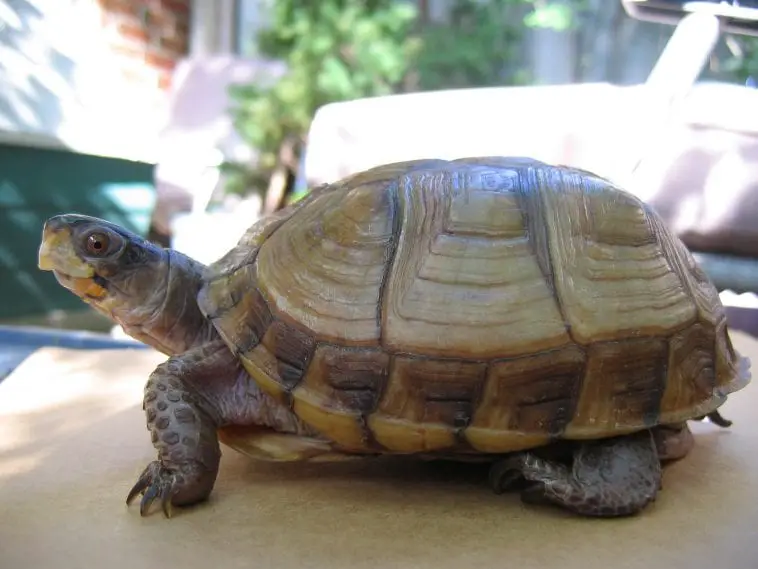The three-toed Box Turtle, also known to its scientific name Terrapene Carolina triunguis, derived its name from the number of its toes on each of its hind feet. While the other kinds of box turtles have their four toes located on the back of their feet. These attractive, good-looking kinds of turtles are native from the United States, and they belong to the most well-known pets for those turtle lovers.
These three-toed box turtles or simply called as box turtles in general, are not particularly convenient to be as pets for new turtles owners or even in homes having very young kids. They literally are in need of an important amount of care, unlike other types of turtles as well as they prefer stability in their environments because even just a simple ride to take them to a veterinarian can show stressful for your pet box turtle.
The Three-toed Box Turtles has a tall mound carapace or simply called as turtle’s shell. It is commonly a color olive-brown with a few yellow markings. There are also some dark areas on its plastron or its chest. Females have a skin that is color brown with a few yellow spots while the males have are markings on its heads, and occasionally it may be red, orange, or black on their legs as well as their forelegs.
Males usually have a longer and wider tail than the females’ three-toed box turtles. Furthermore, their chests are a little concave in males and usually flatter than females. The males also have red irises, and the claws on their hind feet are tinier and more curved than those on the female’s three-toed box turtles.
Things You’ll Need to Keep Your Three-toed Box Turtle
Three-toed Box Turtle Caging
Your Three-toed Box Turtle required having an appropriate caging for them to live a comfortable and happy life. They usually do their best whenever they are living outside in a big and naturalistic-like pen. Their outdoor cage must be built in a soil that is well-draining, having a rot-resistant wall that has at least 20 inches in height. The barrier may expand at least 10 inches under the ground at each of its perimeter walls to avoid the turtles from digging down.
Access to a spot that is sunny, as well as has a shade, should be accessible so that your turtle can maintain its regular temperature. Having small shrubs, small trees with fruit, ground cover, as well as tiny logs, may offer a shade, can be as a hiding place and sight break to your turtle. You may also provide at all times a large shallow water pan so that your turtle can have a source for them to drink water and for them to soak.
Because of the small size of the box turtles, it makes them easy to be as house indoors pet. As an owner, you can keep your box turtle in good health as long as the turtle has sufficient space, genuine temperature span, closeness, and provide filled spectrum radiation. Indoor enclosures required to be as big as possible so that the light and the fixtures and even the hides or the sight breaks, as well as the water dishes of the turtle, can be positioned in a proper place. If possible, you may also provide a hygrometer and a digital thermometer for you as an owner to prevent assumptions about the proper need of your turtle a temperature and humidity.
Food

Caged box turtles might become financial eaters. The best way to avoid this is to supply the turtle a variety of food items during every meal. Different foods may help your turtle box to help it to ensure to sustain the nutrition they need to stay healthy. A mature box turtle can feed at least two or three times per week, while the offspring or the young turtles can be required to feed every other day.
This kind of turtles will accept any kind of plant as well as animal matter. Plants may include a food that is a quality source of protein like dark leafy greens, fruits, vegetables, and fungi. You may also offer them occasionally a live insect for them to provide for their complete diet. While in the animal matter, these may comprise such as nightcrawlers, earthworms, crickets, mealworms, super worms, moth larvae, as well as lean pork and cooked beef.
Your pet box turtle can be fed by common kinds of fruits and vegetables. The fruit selection maybe consists of an apple, grapes, persimmons, cherries, cantaloupe, strawberries, bananas, and also a mulberry. While in vegetables, this may include a delicately steamed sweet potato and squash. This may also consist of zucchini, tomatoes, carrots, corn, green beans, or peas. The best selection of leafy greens includes re leaf lettuce, bibb lettuce, kale, and arugula. You can also be occasionally used the spinach that is high in oxalic acid content for the calcium supplements.
The risk with any of those food items is when you use those one or two times exclusively. Give a cuttlebone to your pet box turtles all the time. You may feed your pet turtles on a hard and flat surface; this may help your pet to trimmed is beaks. One or two times a week, you may sprinkle a reptile vitamin or a mineral additive that restrain calcium and D3 on the food of your pet with the right amount or as the recommended dosage of a veterinarian. Always take away the uneaten food quickly to lessen the existence of ants or any other pets to your pet’s enclosures.
Water
Every turtle has needed a consistent supply of water. Whether they are housed indoors pet or outdoor pets. A common cause of the illness is usually dehydration. Clean water must be supplied in a shallow water container like plastic roller paint pans or plastic plant saucers, which are easy to clean containers, and usually, most turtles can enter them without any hesitation.
But if you have a turtle that does not prefer to use the pans, try to place the water dish with the same level of the substrate or ground. Usually, a very young turtle box is placed in the water they soak the little hatchlings as well as the very young turtles in a lukewarm water a number of times a week for at least 10 up to 15 minutes just to make sure that the hatchlings are well hydrated.
Common Health Problems
Just like the other kinds of turtles, the three-toed box turtle is also capable of the vitamin A deficiency, shell decay as well as the internal parasites. Common health problems also include respiratory infections. Vitamin A deficiency is commonly the outcome of a poor nutrient diet of the turtle.
Even though they prefer leafy greens, different kinds of leafy greens such as iceberg lettuce. This does not mean that they have enough nutritional value for turtles. The different indication that your pet might have a respiratory infection includes of open-mouthing breathing, breath audibly, discharge in its nasal, and even drooling. These two common health problem conditions usually go hand in hand.
Lastly, the shell rot is the consequence of either bacterial or fungal infection. This state is considered as serious and painful for your pet turtle, and just like any other usual illness, this one should be tended to treat by a veterinarian who specializes in reptiles. Occasionally, shell rot occurs after an injury that happens to a turtle’s shell. You may also include the parasite infections; this is commonly hard to detect by a pet owner except during the veterinary exam.
Hibernation

During cold temperatures, as well as the insufficiency of food and water, cause the three-toed box turtles to look for shelter and hole up underground to endure the adverse conditions. In spite of the fact that the hibernation or as simply called brumation is normal conduct and it is not without dangers, but there are times that box turtle will not survive the winter. You must look for an appropriate location during hibernation, a place that can provide protection from cold, floods as well as in predators.
The turtle must be in vigorous health so that they do not give in to such diseases within the winter season. The captive box turtles tend to depend on their owners to give them the right care for them to ensure good health. It is a rightful choice to view how the pens can handle the peculiarity of a full winter. You must know if the pen is the area of flood during spring, or the soil is acceptable for digging. You must also observe if there are any risk might happen or state that will not authorize during for a safe hibernation.
Handling and Temperament
Generally, the most number of the Three-toed Box turtle tends to acknowledge its owner’s voice as well as its touch and will allow gentle grasping.
A few numbers of box turtles don’t like the idea to be held, but they can still be enjoyed to be as pets. The box turtles may don’t have a free span inside its room or in your home. They might be off-track as well as get hurt for over a long period. They might be also hurt from deficient temperature and humidity.
Conclusion
Now you’re more confident to care for your three-toed box turtle by following the tips shared in this article. No matter how delightful a Three-toed box turtle has always kept in mind that their biology involves exclusive surroundings, food, diet, and special care for them to have a healthy and good life.



